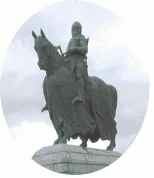|
FAMOUS SCOTS: Robert the Bruce
 During a time when unity across Europe is uppermost in the minds of British leaders and peace and harmony the objective of any right-minded person, it is strange to remember that once Scotland and England were the bitterest of enemies. Atrocities in the name of so called "ethnic cleansing" were being committed by Briton on fellow Briton as Scotland's War of Independence raged between 1291 and 1328. During a time when unity across Europe is uppermost in the minds of British leaders and peace and harmony the objective of any right-minded person, it is strange to remember that once Scotland and England were the bitterest of enemies. Atrocities in the name of so called "ethnic cleansing" were being committed by Briton on fellow Briton as Scotland's War of Independence raged between 1291 and 1328.
The English, under Edward 1 invaded Scotland and declared the country a vassal state with lands and rights being gifted to Anglo - Norman nobles. It was during this time that the Scottish nobleman Robert Bruce, Earl of Carrick, was converted to the patriotic cause. He went on to be crowned King of Scots in 1306.
Many say that it was the inspiration of William Wallace that turned Bruce to the independence cause. Bruce was involved in his first action in 1305 where he lost heavily at Methven. After recouping he went on to successfully harry the English in actions at Glen Troul, Pass of Brander and culminating in the famous victory at Bannockburn in 1314.
Bannockburn is considered to be one of the classic land battles of all time. Bruce totally out maneuvered, out thought and out fought his opponent. When you look at the difference is military strength between the two sides he had to.
The Scottish army was made up of no more than six thousand men. They were mostly lightly armed and could call on only 500 light horse and a small company of Ettrick archers for support.
By comparison Bruce's adversary, Edward II, had amassed the largest army that any English monarch had ever commanded. Some reports claim that it was made up of almost twenty four thousand men. It comprised of 2500 heavy cavalry. Each rider was clad in chain mail and was armed with battle axes and swords. Each of them also carried a 12-foot long lance.
Also on the English side of the battlefield were 3000 Welsh archers. This much-feared group of men were experts in the use of the longbow and could fire their arrows with such speed that each archer could have as many as five arrows in the air at the one time.
The main body of Edward's army consisted of 15,000 foot soldiers who were protected by steel helmets and heavily quilted coats. They each carried a spear, shield and sword.
Bruce had spent a year training and inspiring his men. His greater leadership qualities married to the patriotic fervour and the inbuilt fighting nature of his warriors carried the day.
In 1320 the Scottish nobility signed the Declaration of Arbroath. Its most famous passage reads: "For so long as one hundred of us remain alive, we shall never in any wise submit to the domination of the English, for it is not for glory we fight, for riches or for honours, but for freedom alone, which no good man loses but with his life"
Scotland's Treaty of Independence was signed in 1328 and never again would its very existence be denied. This was Robert the Bruce's proudest moment and was a major turning point in Scotland's long and bloody history.
|



